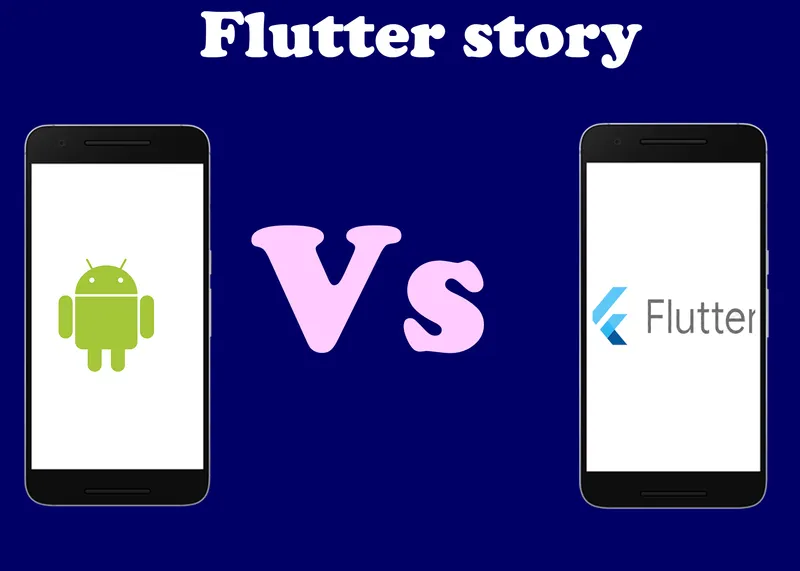

Android App Development Company should concentrate to Flutter now a days
what is need a flutter in android and iOS app development company?
What is Flutter?
Flutter is one of the Google's mobile application SDK, complete with a structure, widgets, and tools, that gives designers a simple method to assemble and convey outwardly attractive, quick mobile applications on both Android and iOS stages.
Flutter is an open-source, multi-stage portable SDK which can be utilized to build iOS and Android applications with similar source code. It's been almost for quite a while, yet it had begun getting more consideration since Google I/O 2018 when Google declared discharge review of Flutter. At Flutter Live on fourth December 2018, Google announced the main stable variant of Flutter with heaps of new highlights. Some large organizations like Alibaba are as of now utilizing it for creating mobile applications.
Android and Flutter, both are known as the babies of Google. One organization overseeing both the local and cross-stage mobile application development for Android app development company. Android application development was begun at Android Inc, which was purchased by Google in 2005. The Flutter venture started at Google and the first since forever Flutter SDK was released in 2017. It would be amazingly satisfying to contrast local Android development and Flutter application development and to perceive what might be the future of Android with the ascent of Fuchsia. We should investigate and attempt to respond to every one of these inquiries.

All Organizations are searching for choices to create applications inside a brief span and with a constrained spending plan. Local mobile application development for iOS or Android dependably requires two different tech stacks, which results in two unique groups and more significant expense. This is the motivation behind why organizations began searching for cross-stage arrangements. The popularity of the React-Native structure is one of the instances of this reality.
Except if you are living on a little island without the web, you more likely have heard about Flutter. This is another cross-stage compact development structure blasting in the market as of late. In this post, we will investigate the potential effect of Flutter on local Android development and examine why we should focus on it.
In case you're interested in finding out additional, check my nitty gritty examination of Flutter and React Native.
Flutter vs. native Android app development
Local Android application development is fascinating right now. As of late, Google reported Kotlin as the official language over Java. Google is likewise dealing with another working framework for both Chrome and versatile, which is Fuchsia.
There is no uncertainty that local Android applications developed with Android Studio are incredible in highlights and smooth. Then again, apps created with cross-stage arrangements can be effectively spotted, and it feels like something is missing. Nonetheless, as far back as Flutter applications arrived in application stores, there is no real way to tell that the claims were built with Flutter. The applications feel so smooth, local, and smooth. So, what's Flutter that makes applications feel pretty much local?
Many local Android engineers have communicated their assessments on Flutter on the web. One of the articles here clarifies an Android engineer's view on Flutter. Likewise, there's a heated discussion on Quora if Flutter will supplant Java and local Android development. Taking a gander at all these articles, obviously, local Android designers can't overlook Flutter without a doubt.
Flutter is not the same as the local Android development tools. Flutter's documentation has a reasonable guide on Flutter for Android engineers, mapping the ideas of local Android development to Flutter.
How about we contrast Flutter and native Android development utilizing some fundamental criteria:
• Technical architecture
• Developer productivity
• UI parts
• Testing support
• CI/CD support
Technical architecture
The tech stack used for native Android development and Flutter is extraordinary.
As far as IDE, Android Studio can be utilized for both Flutter and local Android application development. In any case, Flutter applications can likewise be created in lightweight editors, example Sublime Text, Atom or VIM, or in an IDE like IntelliJ Idea.
As we probably know, native applications worked with Java/Kotlin are smooth and quick as every one of the segments is manufactured natively. Flutter utilizes the Dart system and regularly does not require the scaffold to speak with the native modules. The design of the Flutter motor is clarified in detail in GitHub Wiki here.
To put it plainly, Flutter has everything required for local application advancement in the Flutter motor itself. The domestic Android engineer's guide clarifies the whole biological system of Android application development.
Developer productivity
While creating applications locally, Android developers need to utilize Android Studio and the local form and stage devices given by Android Studio. Android Studio has all the SDK devices inserted inside the IDE. These devices additionally need emulators or Virtual Android gadgets to run the applications. Each time designers make changes to the form; they need to revamp the application or outsider conditions now and again to see the adjustments in the emulator or on gadgets. As a local Android engineer, you may have encountered this reasonable procedure as Gradle constructs can require significant investment.
In Flutter, there is a hot reload choice. At the point when an engineer rolls out any development, the progressions show up in the emulator or gadgets quickly. In any case, as the application develops in size, engineers need to adopt new strategies to utilize this component viable.
On another note, Dart is certifiably not a standard programming language, and there is an absence of help for it in many IDEs and word processors. It might be a precarious expectation to learn and adapt for the designers to become familiar with the new dialect. While Java has been there for quite a long time and Kotlin is a sort safe language, local dialects feel substantially more benevolent with Android Studio. There are bunches of network support for regional dialects too.
UI components
Front-end engineers invest a large portion of the energy in structure the UI.
The local UI segments given by Google to manufacture UI are so amazing and very much reported. The UI can be likewise assembled utilizing the interface developer in Android Studio. With that highlight, UI can be constructed quicker using the local improvement apparatuses. Android UI docs spread all the fundamental data expected to assemble a wide range of UI components.
Shudder UI motor is extraordinary; Flutter applications keep running on its rendering motor and its structure. Shudder utilizes the idea of gadgets which can be used to fabricate complex UIs. To put it plainly, the Flutter UI is essentially a tree of stateless or stateful devices. There are heaps of gadgets in the index accessible to construct complex UIs which bolster both Material Things for Android and Cupertino for iOS. The Flutter format and devices are pixel impeccable too.
Testing Support
Local Android devices have amazing help for testing. Domestic applications can be tried effectively from Android studio itself or order line utilizing Gradle. You can include unit, integration, instrumented, and UI tests for Android apps. There are such a significant number of Java, and Kotlin structures like JUnit accessible for lower level testing and Espresso is bolstered for UI testing. There is effortless help for taunting things with systems like Mockito. Android testing has been widely shrouded in documentation; you can allude to the various dimensions of testing Android applications here.
Flutter gives a strong testing structure which enables engineers to compose tests at the unit, practical, and UI level. Gadget testing is one cooling component that Flutter gives to run UI tests as quick as unit tests. Shudder has fresh documentation on the most proficient method to test Flutter applications at various dimensions with precedent code. Ripple mix tests are like Xcode UI tests which experience the UI to perform specific activities. The Flutter incorporation tests keep running in a different procedure and can be kept running on useful gadgets or test systems or emulators. Ripple gives a separate bundle, Flutter Driver, to drive these tests.
CI/CD support
Constant joining and continuous delivery practices take into consideration the quicker delivery of Android applications.
The way toward structure and distributing local Android applications is somewhat mind-boggling outside the IDE. Domestic android applications have trustworthy help for automation testing, assemble computerization and distributing from Android studio. Be that as it may, Google hasn't given a committed CI/CD stage for Android. Local Android engineers need to depend on outsider CI servers like Jenkins, TeamCity, or versatile CI administrations like Travis CI, Circle CI, Never one, Beatrice, and so on. Fortunately, local Android applications can be likewise based on Linux, so the CI/CD part for Android is more straightforward in examination with iOS apps. It generally requires extra setup to convey native Android applications utilizing other CI administrations.
On the opposite side, the Flutter group at Google banded together with Never code and reported Codemagic CI/CD arrangement only for Flutter applications at Flutter Live, London. Codemagic is a comfortable CI/CD arrangement created at Never code which naturally identifies, manufactures, tests, and bundles the Flutter application with zero design. With Codemagic, Flutter applications can be assembled, tried, and sent to Play store effectively.
We have quite recently looked at both Google's native and cross-stage answer for portable application advancement, that is, Android and Flutter. Nonetheless, we can't close, which is the best as it thoroughly relies upon the venture, organization, spending plan, and setting.






